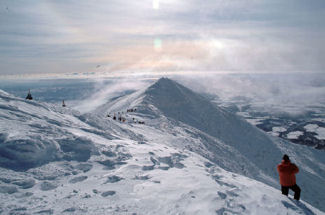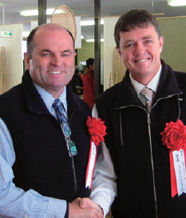Nihon Harmony Resorts
Nihon Harmony Resorts
 Australia is known for its summery attractions, such as the Gold Coast beaches and the diving at the Great Barrier Reef. But Australians are avid year-round sportspeople, and winter sports are high on their list of leisure activities. The world’s great ski areas are not easy to access from the Southern Hemisphere, though, and for a long time only the most dedicated Australian skiers and snowboarders made the lengthy trips to the Rocky Mountains of North America or the European Alps.
Australia is known for its summery attractions, such as the Gold Coast beaches and the diving at the Great Barrier Reef. But Australians are avid year-round sportspeople, and winter sports are high on their list of leisure activities. The world’s great ski areas are not easy to access from the Southern Hemisphere, though, and for a long time only the most dedicated Australian skiers and snowboarders made the lengthy trips to the Rocky Mountains of North America or the European Alps.All this is changing now, though, thanks to the efforts of Nihon Harmony Resorts KK
 Mr. Roger Donazzan, executive chairman of Nihon Harmony Resorts, first heard about the skiing opportunities in Japan in 2003. Colin Hackworth, now managing director of the company, told him about the Hokkaido experience just 10 hours from Australia, compared with more than 20 hours to get to Canadian resorts, and surprisingly inexpensive. Says Mr. Donazzan: “When he told me that Australians were just starting to go now, I said ‘is there anything for sale?’”
Mr. Roger Donazzan, executive chairman of Nihon Harmony Resorts, first heard about the skiing opportunities in Japan in 2003. Colin Hackworth, now managing director of the company, told him about the Hokkaido experience just 10 hours from Australia, compared with more than 20 hours to get to Canadian resorts, and surprisingly inexpensive. Says Mr. Donazzan: “When he told me that Australians were just starting to go now, I said ‘is there anything for sale?’”The pair began examining investment opportunities in Japan right away, eventually focusing on Hanazono, an area in the Niseko complex of ski resorts. “We began working on the project before I’d actually seen the property,” notes Mr. Donazzan. “We went through JETRO in Melbourne. We were looking for someone who could help us through the negotiations, and who could aid us in our discussions with Tokyu.” Introductions from JETRO helped the Australians find the intermediaries they needed to facilitate talks with Tokyu Land Corporation, which owned the Hanazono property at the time.
It was Niseko’s great snow that was most attractive to the investors at first—not to mention the altitude of the Niseko slopes. Compared to ski areas in Canada and the Alps, which can top out at more than 3,000 meters, the 1,000-meter hills of Niseko are welcome to skiers and snowboarders worried about altitude sickness. But there was more than geography to make the investment attractive. “The opportunity was obvious,” says Mr. Donazzan. “Our timing was also good, because the assets were a very good value.” He points to recent regulatory changes in Japan requiring companies to report property values more accurately for tax purposes as a factor increasing the amount of attractive investment targets in the country.
Visitation to the resort has been climbing quickly among Australians, as well as Western expatriates living in other parts of Asia. Nihon Harmony Resorts has been working to make its ski area accessible to these foreign visitors, putting together a multilingual website and guidebook to Niseko and ensuring that signs are posted in English as well as Japanese. “In the last year in particular, we saw lots of families,” Mr. Donazzan notes. “Aggressive skiers go all over the world; now we’re reaching a deeper, broader market of people who stay much longer.”
 The Australian firm has seen steady climbs in the number of skiers since buying the property in December 2004. And many of those skiers are Japanese. Mr. Donazzan stresses that Nihon Harmony wants to create an internationally friendly resort that is Japanese at heart. “It’s very important to us that this remain a Japanese destination.” Some 80% of visitors are domestic travelers, and Japanese winter sports fans are a key market for the company’s publicity efforts. The firm is also working closely with the other companies operating on the mountain—actually a network of ski areas spanning several hills, with lifts run by four separate companies and a number of hotels at the foot of the slopes.
The Australian firm has seen steady climbs in the number of skiers since buying the property in December 2004. And many of those skiers are Japanese. Mr. Donazzan stresses that Nihon Harmony wants to create an internationally friendly resort that is Japanese at heart. “It’s very important to us that this remain a Japanese destination.” Some 80% of visitors are domestic travelers, and Japanese winter sports fans are a key market for the company’s publicity efforts. The firm is also working closely with the other companies operating on the mountain—actually a network of ski areas spanning several hills, with lifts run by four separate companies and a number of hotels at the foot of the slopes.Mr. Donazzan says that from the beginning, the company stressed its cooperative, not competitive, role: “We spoke to the locals and told them, ‘Our competitors aren’t here—they’re in Europe, North America, and the rest of Japan.’” He sees this group-based approach to making the area more attractive as one likely to pay off in longer visits—particularly among Japanese tourists, who now stay an average of just a couple nights compared to a week or more for foreign visitors.
The company’s current operations include the ski area, its system of lifts, a skiing and snowboarding school, and equipment rental and sales. With the land at its disposal, Niseko Harmony Resorts is looking forward to the development of luxury residences, holiday condominiums and apartments, and a full range of restaurants and shops that will make long-term stays easier and more affordable, particularly for families. The firm will also focus on bolstering its year-round offerings, including tennis, golf, and a network of nature trails. In the long run the company aims to make Niseko one of the premier vacation destinations in the Northern Hemisphere—an international resort with something for everyone.
2004 Harmony Resorts Niseko Pty Ltd and Japanese subsidiary Nihon Harmony Resorts KK established
2004 Acquisition of Hanazono ski area and development land at Mt. Niseko Annapuri in December; ski area operations commence
2005 Acquisition of Niseko Tokyu Golf Course at Hanazono in March
2005 Plan published in July for Hanazono Village development
2006 Property investment opportunities announced in Hanazono in November/December





